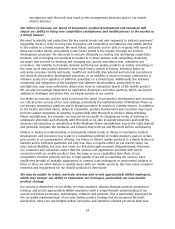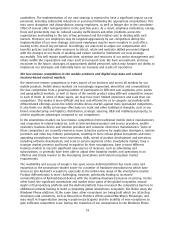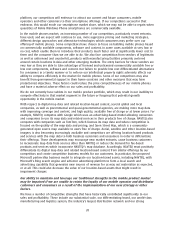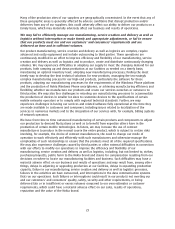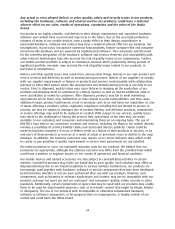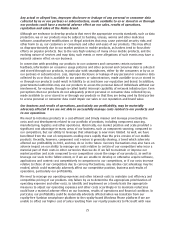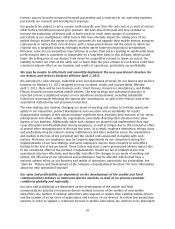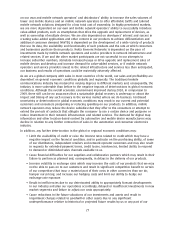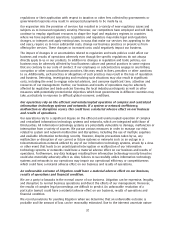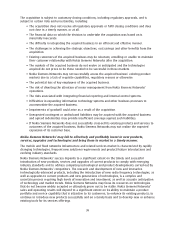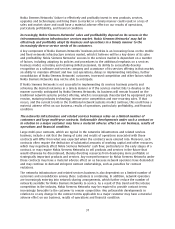Nokia 2010 Annual Report Download - page 29
Download and view the complete annual report
Please find page 29 of the 2010 Nokia annual report below. You can navigate through the pages in the report by either clicking on the pages listed below, or by using the keyword search tool below to find specific information within the annual report.business or any significant changes in the manner of our use of acquired assets or the strategy
for our overall business.
• Cause lowered credit ratings of our short and longterm debt or their outlook from the credit
rating agencies and, consequently, impair our ability to raise new financing or refinance our
current borrowings and increase our interest costs associated with any new debt instruments.
• Result in failures of derivative counterparties or other financial institutions which could have a
negative impact on our treasury operations.
• Result in increased and/or more volatile taxes which could negatively impact our effective tax
rate.
• Impact our investment portfolio and other assets and result in impairment.
We currently believe our funding position to be sufficient to meet our operating and capital
expenditures in the foreseeable future. However, adverse developments in the global financial
markets could have a material adverse effect on our financial condition and results of operations. For
a more detailed discussion of our liquidity and capital resources, see Item 5B. “Liquidity and Capital
Resources” and Note 35 of our consolidated financial statements included in Item 18 of this annual
report.
Our net sales, costs and results of operations, as well as the US dollar value of our dividends
and market price of our ADSs, are affected by exchange rate fluctuations, particularly between
the euro, which is our reporting currency, and the US dollar, the Japanese yen and the Chinese
yuan, as well as certain other currencies.
We operate globally and are therefore exposed to foreign exchange risks in the form of both
transaction risks and translation risks. Our policy is to monitor and hedge exchange rate exposure,
and we manage our operations to mitigate, but not to eliminate, the impacts of exchange rate
fluctuations. There can be no assurance, however, that our hedging activities will be successful in
mitigating the impact of exchange rate fluctuations. In addition, significant volatility in the exchange
rates may increase our hedging costs, as well as limit our ability to hedge our exchange rate
exposure in particular against unfavorable movements in the exchange rates of certain emerging
market currencies and could have an adverse impact on our results of operations, particularly our
profitability. Further, exchange rate fluctuations may have an adverse affect on our net sales, costs
and results of operations, as well as our competitive position. Exchange rate fluctuations may also
make our pricing more difficult as our products may be rerouted by the distribution channels for sale
to consumers in other geographic areas where sales can be made at more favorable exchange rates
by those channels. Further, exchange rate fluctuations may also materially affect the US dollar value
of any dividends or other distributions that are paid in euro as well as the market price of our ADSs.
For a more detailed discussion of exchange risks, see Item 5A. “Operating Results—Certain Other
Factors—Exchange Rates” and Note 35 of our consolidated financial statements included in Item 18 of
this annual report.
Our products include increasingly complex technologies, some of which have been developed
by us or licensed to us by certain third parties. As a consequence, evaluating the rights related
to the technologies we use or intend to use is more and more challenging, and we expect
increasingly to face claims that we have infringed third parties’ intellectual property rights.
The use of these technologies may also result in increased licensing costs for us, restrictions
on our ability to use certain technologies in our products and/or costly and timeconsuming
litigation, which could have a material adverse effect on our business, results of operations
and financial condition.
Our products include increasingly complex technologies, some of which have been developed by us
and some by third parties. As the amount of such proprietary technologies and the number of parties
claiming intellectual property rights continues to increase, even within individual products, as the
28


